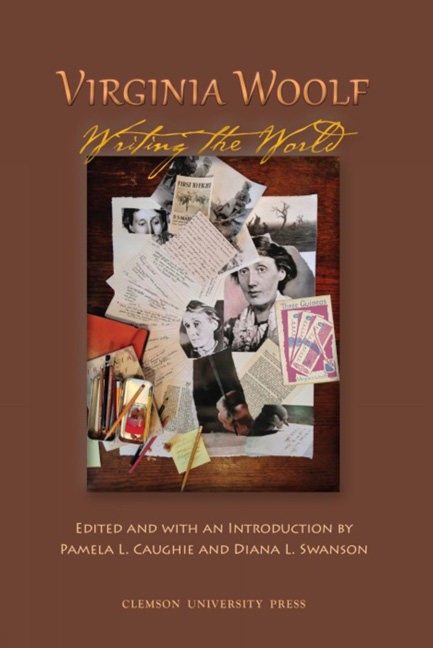Book contents
- Frontmatter
- Table of Contents
- Introduction
- Acknowledgmen
- Abbreviation
- WAR AND PEACE
- WORLD WRITER(S)
- ANIMAL AND NATURAL WORLD
- WRITING AND WORLDMAKING
- Negative Feminism and Anti-Development in Virginia Woolf's The Voyage Out
- Upheavals of Intimacy in To the Lighthouse
- The Reconciliations of Poetry in Virginia Woolf's Between the Acts; or, Why It's “perfectly ridiculous to call it a novel”
- Virginia Woolf, Composition Theorist: How Imagined Audiences Can Wreck a Writer
- The Precarity of “Civilization” in Woolf's Creative Worldmaking
- Notes on Contributors
- Conference Program
- Appendix: Virginia Woolf Conference Exhibit Items, Newberry Library
Negative Feminism and Anti-Development in Virginia Woolf's The Voyage Out
from WRITING AND WORLDMAKING
- Frontmatter
- Table of Contents
- Introduction
- Acknowledgmen
- Abbreviation
- WAR AND PEACE
- WORLD WRITER(S)
- ANIMAL AND NATURAL WORLD
- WRITING AND WORLDMAKING
- Negative Feminism and Anti-Development in Virginia Woolf's The Voyage Out
- Upheavals of Intimacy in To the Lighthouse
- The Reconciliations of Poetry in Virginia Woolf's Between the Acts; or, Why It's “perfectly ridiculous to call it a novel”
- Virginia Woolf, Composition Theorist: How Imagined Audiences Can Wreck a Writer
- The Precarity of “Civilization” in Woolf's Creative Worldmaking
- Notes on Contributors
- Conference Program
- Appendix: Virginia Woolf Conference Exhibit Items, Newberry Library
Summary
Virginia Woolf toiled over her first novel The Voyage Out for years before finally publishing it in 1915. While lacking in the formal experimentation and innovation representative of her middle and late period work, The Voyage Out is more radical than most critics give it credit for. The novel raises the question of whether a woman can be “a self-determining individual within the conventions and institutions of patriarchal society and, through Rachel Vinrace's failure, seems to answer with a resounding ‘no’” (Pease 100). The Voyage Out complicates the genre of the Bildüngsroman through failure. The young protagonist is unable to inhabit the (usually male) space of maturation and earn her place in the world. Rachel does not achieve significant moral or psychological development through the course of the novel nor does she go on to live a life of purpose after putting her disappointments and mistakes behind her.
I briefly consider here how Woolf's feminist critique in her first novel is linked to a negative feminism and a modernist aesthetic of failure. I am currently working on a larger project on women writers and a modernist feminine aesthetic of failure in the novels of Jean Rhys, Nella Larsen, Djuna Barnes, and Virginia Woolf in which I illuminate how a failure-based aesthetics evinces a commitment to negativity that extends to a feminist practice, and I argue that by rejecting restrictive codes of femininity, these authors’ negative female protagonists enact an alternative model of feminine subjectivity based on failure that critiques normative prescriptive codes.
Woolf's Rachel Vinrace enacts a form of shadow feminism—J. Halberstam's concept used to describe an “anti-social, or negative feminism” grounded in refusal, failing and passivity (4). Because readings of Woolf's corpus overlook shadow feminism and tend to explain away the non-triumphant Rachel Vinrace by turning to Woolf's later successful female characters, I discuss The Voyage Out here in its own right, to highlight how reading Woolf through a positivist feminist lens obscures shadow feminism. Such readings, I argue, narrow the scope of feminist inquiry.
The novel begins as the widowed Willoughby Vinrace ships off his socially awkward daughter Rachel to South America with her Uncle Ridley and Aunt Helen, in hopes of improving her social graces.
- Type
- Chapter
- Information
- Virginia Woolf: Writing the World , pp. 180 - 184Publisher: Liverpool University PressPrint publication year: 2015



